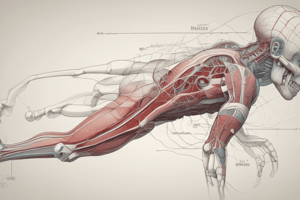Podcast
Questions and Answers
What is the eye orbit?
What is the eye orbit?
- Around the ear
- Around the nose
- Around the eye (correct)
- Around the mouth
What is the mandible?
What is the mandible?
The lower jaw
What is the body of sternum?
What is the body of sternum?
Unknown
What is the xiphoid?
What is the xiphoid?
What is coastal cartilage?
What is coastal cartilage?
What is the symphysis pubis?
What is the symphysis pubis?
What is the ilium?
What is the ilium?
What are floating ribs?
What are floating ribs?
What is the ischium?
What is the ischium?
What is the frontal bone?
What is the frontal bone?
What is nasal?
What is nasal?
What is the maxilla?
What is the maxilla?
What is the clavicle?
What is the clavicle?
What are true ribs?
What are true ribs?
What is the humerus?
What is the humerus?
What are lumbar vertebrae?
What are lumbar vertebrae?
What is the ulna?
What is the ulna?
What is the radius?
What is the radius?
What is the sacrum?
What is the sacrum?
What is the coccyx?
What is the coccyx?
What are carpals?
What are carpals?
What are metacarpals?
What are metacarpals?
What are phalanges?
What are phalanges?
What is the femur?
What is the femur?
What is the patella?
What is the patella?
What is the tibia?
What is the tibia?
What is the fibula?
What is the fibula?
What is tarsal?
What is tarsal?
What is metatarsal?
What is metatarsal?
What are the phalanges?
What are the phalanges?
Flashcards are hidden until you start studying
Study Notes
Eye and Facial Bones
- Eye Orbit:
- Encases and protects the eye.
- Mandible:
- Forms the lower jaw, crucial for chewing and speaking.
- Frontal Bone:
- Comprises the forehead region.
- Nasal Bone:
- Forms the bridge of the nose.
- Maxilla:
- Constitutes the upper jaw, important for dental structure.
Thoracic and Upper Limb Bones
- Body of Sternum:
- Central part of the sternum, articulates with ribs.
- Xiphoid:
- The small, cartilaginous extension at the lower end of the sternum.
- Clavicle:
- Known as the collarbone, connects arm to body and provides shoulder support.
- True Ribs:
- The first seven pairs of ribs that attach directly to the sternum.
Arm and Forearm Bones
- Humerus:
- The long bone in the upper arm, involved in shoulder and elbow movement.
- Ulna:
- Larger forearm bone, features a hinge joint at the elbow for uniplanar movement.
- Radius:
- Smaller forearm bone, enables rotational motion at the elbow.
Vertebral and Pelvic Bones
- Lumbar Vertebrae:
- Five vertebrae in the lower back, significant for supporting the torso.
- Sacrum:
- Triangular bone at the base of the spine, connects with pelvis.
- Coccyx:
- Known as the tailbone, supports pelvic organs.
Pelvic and Lower Limb Bones
- Ilium:
- The largest part of the pelvis, supports weight and provides attachment points.
- Ischium:
- The lower and back part of the hip bone, provides sitting support.
- Symphysis Pubis:
- A joint that connects the left and right pubic bones at the front of the pelvis.
Rib and Cartilage Structure
- Coastal Cartilage:
- Connects each rib to the sternum, providing flexibility to the ribcage.
- Floating Ribs:
- The last two pairs of ribs that do not attach to the sternum but protect the kidneys.
Hand and Foot Bones
- Carpals:
- Group of eight small bones forming the wrist, allowing wrist mobility.
- Metacarpals:
- Five bones forming the palm of the hand.
- Phalanges:
- Bones of the fingers and toes; essential for dexterity and grip.
- Tarsals:
- Group of seven bones forming the ankle, providing support and mobility.
- Metatarsals:
- Slender bones forming the middle part of the foot.
Leg Bones
- Femur:
- The longest bone in the body, known as the thigh bone.
- Patella:
- Also known as the kneecap, protects the knee joint.
- Tibia:
- The larger of the two leg bones, significant for weight-bearing.
- Fibula:
- The smaller of the two leg bones, helps stabilize the ankle.
Studying That Suits You
Use AI to generate personalized quizzes and flashcards to suit your learning preferences.





